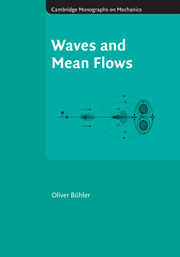Book contents
- Frontmatter
- Contents
- Preface
- Part I Fluid Dynamics and Waves
- Part II Wave–Mean Interaction Theory
- 5 Zonally symmetric wave–mean interaction theory
- 6 Internal gravity waves
- 7 Shear flows
- 8 Three-dimensional rotating flow
- 9 Rossby waves and balanced dynamics
- 10 Lagrangian-mean theory
- 11 Zonally symmetric GLM theory
- Part III Waves and Vortices
- References
- Index
8 - Three-dimensional rotating flow
from Part II - Wave–Mean Interaction Theory
Published online by Cambridge University Press: 29 March 2010
- Frontmatter
- Contents
- Preface
- Part I Fluid Dynamics and Waves
- Part II Wave–Mean Interaction Theory
- 5 Zonally symmetric wave–mean interaction theory
- 6 Internal gravity waves
- 7 Shear flows
- 8 Three-dimensional rotating flow
- 9 Rossby waves and balanced dynamics
- 10 Lagrangian-mean theory
- 11 Zonally symmetric GLM theory
- Part III Waves and Vortices
- References
- Index
Summary
Building on the vertical slice model, both the extension to three-dimensional flow and the addition of Coriolis forces are important and non-trivial steps in classic wave–mean interaction theory. Specifically, in three dimensions we recover the generic 2 + 1 structure of the linear problem, in which we have two gravity-wave modes and one balanced mode controlled by the PV distribution. This leads to the generic importance of the zero-frequency PV mode for strong interactions.
The Coriolis forces lead to source terms in the horizontal momentum budgets and therefore to differences between Lagrangian and Eulerian fluxes of horizontal momentum. As noted before, this leads to the important definition of the Eliassen–Palm flux in the context of wave drag computations. Once again, the zonal pseudomomentum plays a crucial role in formulating the interaction theory.
We briefly recall the governing equations and then look at the modifications of the linear dynamics, including that of pseudomomentum and its flux. This is followed by rotating three-dimensional lee waves and by a discussion of how to simplify the considerably more complicated mean-flow equations in this case. The key concept here is to focus on the vortical mode of the mean-flow response. Finally, because its intrinsic importance in idealized modelling, we discuss the vertical slice model with rotation.
Rotating Boussinesq equations on an f-plane
We consider frame rotation in the traditional approximation, in which only the locally vertical component of the Coriolis vector is retained (cf. §4.2.2) and we work on an f-plane, in which this component is treated as constant.
- Type
- Chapter
- Information
- Waves and Mean Flows , pp. 171 - 185Publisher: Cambridge University PressPrint publication year: 2009

